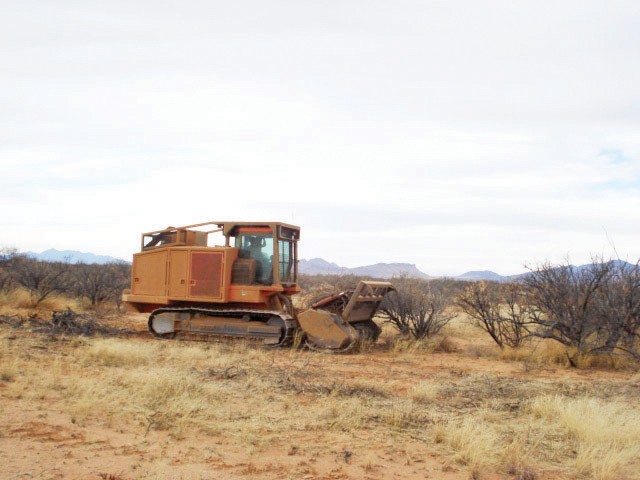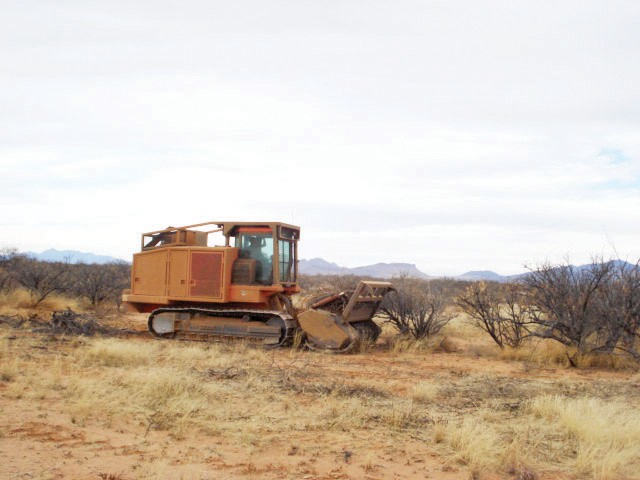FORT HUACHUCA, Ariz--Since the late 1970s, Fort Huachuca has been attempting to rehabilitate degraded grasslands and watersheds, a continual effort by land management agencies in southern Arizona.
Vernadero Group Inc., the Environmental and Natural Resource Division's environmental consultant and contractor, and ENRD personnel have been planning and implementing restoration efforts on the fort.
The East Range Watershed Rehabilitation Project is concentrating the fort's resources toward natural resource improvements. The project includes removal of mesquite and woody brush species, revegetation by reseeding with native grasses, installation of erosion control structures, and cultural resource protection in planned treatment areas.
Overall efforts will continue for many years, with specific annual activities dependent on available funding. This year's project will focus on the Graveyard Gulch area on the southeast side of the East Range. The project is currently underway and will continue into this summer.
The ERRP's goals are to protect the local watershed and enhance training capacity for the Army. This project is in direct support of the Army Sustainable Range Program and federal environmental policy. This project will maximize the capacity, availability and accessibility of ranges and training lands to support training requirements, while protecting the local watershed and cultural resources located on the East Range.
Grassland conditions and trends in Southern Arizona have been well documented for the past 40 years. Substantial changes have occurred, especially in the semi-desert grasslands similar to the East Range. The general causes are a combination of factors over many years, including unmanaged livestock grazing, man's fire-suppression activities, and regional drought. Associated environmental costs of grassland loss include reduced food sources for foraging wildlife, increased sedimentation of streams and associated wetlands, increased flooding and erosion, and loss of usable training land.
Watershed conditions on the fort are considered generally intact and stable, according to ENRD officials. However, throughout large areas on the East Range, mesquite trees and shrubs have come to dominate the landscape. They and other woody brush species directly compete with grasses for nutrients in similar soil types across the East Range and southeastern Arizona.
Mesquite canopies and root systems cause the redistribution of nutrients and soil moisture, resulting in the loss of natural grassland habitat. Grass species hold the topsoil in place, slowing the movement of water across the land and impeding the erosion process. Grasses reduces sediment moving into stream channels and help maintain water quality.
To improve watershed and grasslands, mesquite trees and other woody brush are being extracted with mechanical equipment used in scattered areas where heavy coverage appears. This type of mechanical removal has been conducted by Fort Huachuca personnel as early as the late 1970s and most recently in 2008 by grinding woody material through a process called "mastication," requiring specialized equipment to grind the wood. After mesquite and brush removal, the disturbed areas will be re-seeded with native grasses to improve vegetative cover in concentrated areas on the East Range.
This process will return treated areas to a more natural, historic state, thus providing increased forage for wildlife while helping to reduce erosion.
Special projects associated with road-related erosion will take place in areas where mesquite extraction will take place, providing a systematic approach to reducing erosion. Runoff from failed grasslands generally follows roadways, cutting deep channels in the shoulders of the road. Some roadways are extensively eroded due to water running directly across the road bed. Erosion control projects will shift roadway runoff and drainage to its natural state. Erosion control structures will be erected to reduce erosion and reduce water velocity in these areas.
In addition to mesquite and brush extraction and erosion control on roadways, the watershed restoration project includes protection of cultural resources showing signs of damage caused by erosion. Ranging in date from pioneer settlements to sites as old as 10,000 B.C., cultural resources are abundant in the watershed. Water diversion and erosion control methods will be used to protect selected cultural sites.
In some cases, the hardening of the sites will prevent further damage caused inadvertently by military use and erosion.
For further information, contact Dawn Rohr, ENRD, 533-1867, or, dawn.rohr@us.army.mil.


Social Sharing